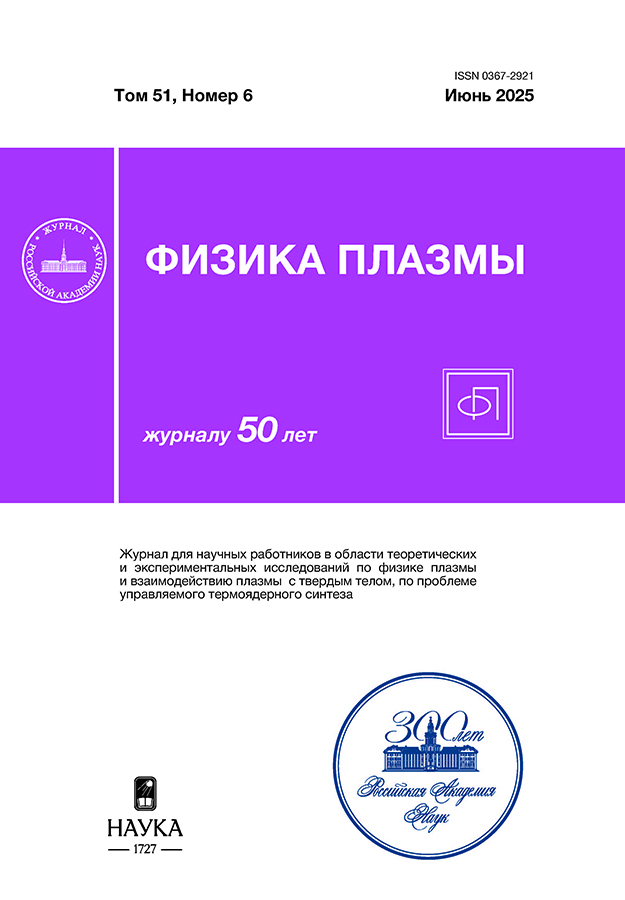Dependence of Sputtering Coefficient on Energy and Incidence Angle of Bombarding Particles. Energy Spectrum and Average Energy of Sputtered Particles by the Example of a Tungsten Target
- Authors: Babenko P.Y.1, Mikhailov V.S.1, Shergin A.P.1, Zinoviev A.N.1
-
Affiliations:
- Ioffe Institute
- Issue: Vol 50, No 9 (2024)
- Pages: 996-1007
- Section: INTERACTION OF PLASMA WITH SURFACES
- URL: https://rjonco.com/0367-2921/article/view/683711
- DOI: https://doi.org/10.31857/S0367292124090026
- EDN: https://elibrary.ru/DVJQUC
- ID: 683711
Cite item
Abstract
The work provides an overview of the functional dependencies (formulas) for describing the properties of atomic particles sputtered during ion bombardment of the surface of a solid body. The dependence of sputtering coefficients on the energy and angle of incidence of the bombarding particle is considered. The energy spectra and average energies of sputtered particles are presented. Using the example of a target made of tungsten and hydrogen isotopes as projectiles, formulas for calculating the quantities under consideration are proposed. These data are necessary to estimate the entry of sputtered tungsten atoms as an impurity into a hot plasma using transport codes. When the tungsten impurity concentration is more than critical, it is impossible to carry out a controlled thermonuclear reaction with the planned energy output in the ITER tokamak reactor. Sputtering coefficients also play an important role in modeling the entry of impurities into plasma installations as a result of the interaction of hydrogen fuel atoms with the materials of the divertor and the first wall.
Full Text
About the authors
P. Yu. Babenko
Ioffe Institute
Author for correspondence.
Email: babenko@npd.ioffe.ru
Russian Federation, St. Petersburg
V. S. Mikhailov
Ioffe Institute
Email: babenko@npd.ioffe.ru
Russian Federation, St. Petersburg
A. P. Shergin
Ioffe Institute
Email: babenko@npd.ioffe.ru
Russian Federation, St. Petersburg
A. N. Zinoviev
Ioffe Institute
Email: babenko@npd.ioffe.ru
Russian Federation, St. Petersburg
References
- Mikhailov V.S., Babenko P.Yu., Shergin A.P., Zinoviev A.N. // Plasma Physics Reports. 2024. V. 50. № 1. P. 23. doi: 10.1134/S1063780X23601682
- Field A.R., Casson F.J., Fajardo D., Angioni C., Challis C.D., Hobirk J., Kappatou A., Kim Hyun-Tae, Lerche E., Loarte A., Mailloux J. // Nucl. Fusion. 2023. V. 63, P. 016028. doi: 10.1088/1741-4326/aca54e
- Pütterich T., Fable E., Dux R., O’Mullane M., Neu R., Siccinio M. // Nucl. Fusion. 2019. V. 59 № 5. P. 056013. doi: 10.1088/1741-4326/ab0384
- Loarte A., Pitts R.A., Wauters T., Nunes I., Köchl F., Polevoi A.R., Kim S.-H., Lehnen M., Artola J., Chen L., Pinches S.D., Bai X., de Vries P., Carvalho I., Dubrov M., Gribov Y., Schneider M., Zabeo L. // ITER Technical Report. ITR-24-004. 2024.
- Pitts R.A., Bonnin X., Escourbiac F., Frerichs H., Gunn J.P., Hirai T., Kukushkin A.S., Kaveeva E., Miller M.A., Moulton D., Rozhansky V., Senichenkov I., Sytova E., Schmitz O., Stangeby P.C., De Temmerman G., Veselova I., Wiesen S. // Nucl. Mater. Energy. 2019. V. 20, P. 100696. doi: 10.1016/j.nme.2019.100696
- Gao B., Ding R., Xie H., Zeng L., Zhang L., Wang B., Li Ch., Zhu D., Yan R., Chen J. // Fusion Eng. Des. 2020. V. 156, P. 111616. doi: 10.1016/j.fusengdes.2020.111616
- Guterl J., Bykov I., Ding R., Snyder P. // Nucl. Mater. Energy. 2021. V. 27, P. 100948. doi: 10.1016/j.nme.2021.100948
- Behrisch R., Eckstein W. Sputtering by Particle Bombardment. Berlin: Springer, 2007. doi: 10.1007/978-3-540-44502-9
- Михайлов В.С., Бабенко П.Ю., Шергин А.П., Зиновьев А.Н. // ЖЭТФ. 2023. Т. 164. В. 3. С. 478. doi: 10.31857/S004445102309016X
- Ziegler J.F., Biersack J.P. SRIM. http://www.srim.org.
- Экштайн В. Компьютерное моделирование взаимодействия частиц с поверхностью твердого тела. М.: Мир, 1995.
- Bohdansky J. // Nucl. Instr. Meth. B. 1984. V. 2. № 1–3. P. 587. doi: 10.1016/0168-583X(84)90271-4
- Falcone G., Gullo F. // Phys. Lett. A. 1987. V. 125. № 8. P. 432. doi: 10.1016/0375-9601(87)90178-2
- Yamamura Y., Tawara H. // At. Data Nucl. Data Tables. 1996. V. 62. № 2. P. 149. doi: 10.1006/adnd.1996.0005
- Sigmund P. // Phys. Rev. 1969. V. 184. № 2. P. 383. doi: 10.1103/PhysRev.184.383
- Фальконе Д. // УФН. 1992. Т. 162. В. 1. С. 71. doi: 10.3367/UFNr.0162.199201c.0071
- Wilson W.D., Haggmark L.G., Biersack J.P. // Phys. Rev. B. 1977. V. 15. № 5. P. 2458. doi: 10.1103/PhysRevB.15.2458
- Eckstein W., Garcia-Rosales C., Roth J., Ottenberger W. Sputtering Data. IPP report 9/82, Garching: IPP, 1993.
- Eckstein W., Preuss R. // J. Nucl. Mater. 2003. V. 320. № 3. P. 209. doi: 10.1016/S0022-3115(03)00192-2
- Eckstein W. // Vacuum. 2008. V. 82. № 9. P. 930. doi: 10.1016/j.vacuum.2007.12.004
- Бабенко П.Ю., Михайлов В.С., Шергин А.П., Зиновьев А.Н. // ЖТФ. 2023. Т. 93. В. 5. С. 709. doi: 10.21883/JTF.2023.05.55467.12-23
- Томпсон М.У. // УФН. 1988. Т. 156. В. 3. С. 513. doi: 10.3367/UFNr.0156.198811d.0513
- Wahl M., Wucher A. // Nucl. Instr. Meth. B. 1994. V. 94. № 1–2. P. 36. doi: 10.1016/0168-583X(94)95655-3
- Kittel C. Introduction to Solid State Physics. 8th edition. N.Y.: Wiley, 2005.
- Eckstein W. Calculated Sputtering, Reflection and Range Values. IPP report 9/132. Garching : IPP, 2002.
- Falcone G. // Phys. Rev. B. 1988. V. 38. № 10. P. 6398. doi: 10.1103/PhysRevB.38.6398
- Бабенко П.Ю., Михайлов В.С., Зиновьев А.Н. // Письма в ЖТФ. 2024. Т. 50 В. 12. С. 3. doi: 10.61011/PJTF.2024.12.58055.19851
- Stuart R.V., Wehner G.K. // J. Appl. Phys. 1962. V. 33. № 7. P. 2345. doi: 10.1063/1.1728959
- Somogyvari Z., Langer G.A., Erdelyi G., Balazs L. // Vacuum. 2012. V. 86. № 12. P. 1979. doi: 10.1016/j.vacuum.2012.03.055
- Wu Sh.-M., van de Kruijs R., Zoethout E., Bijkerk F. // J. Appl. Phys. 2009. V. 106. № 5. P. 054902. doi: 10.1063/1.3149777
- Bohdansky J., Roth J., Bay H.L. // J. Appl. Phys. 1980. V. 51. № 5. P. 2861. doi: 10.1063/1.327954
Supplementary files






















